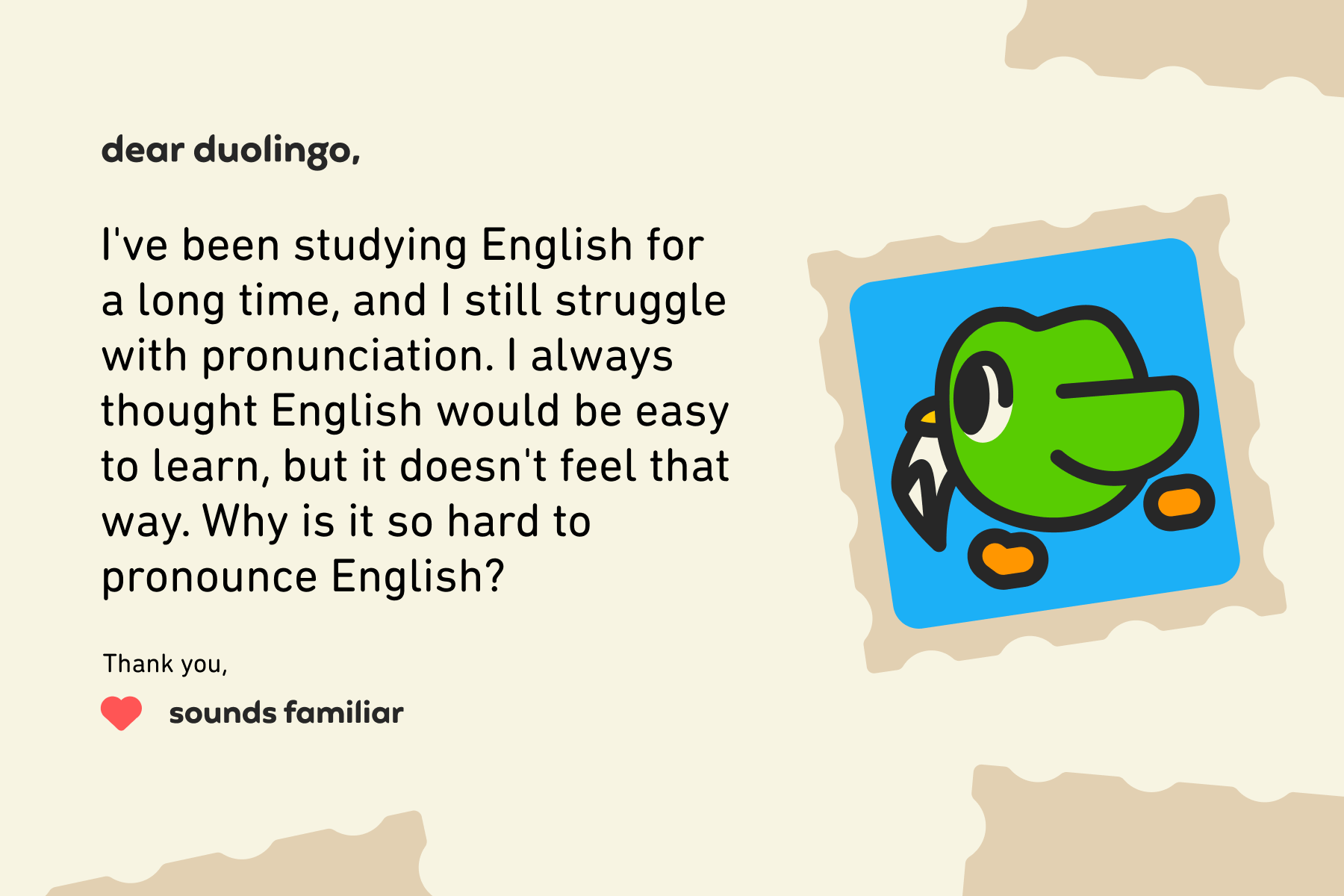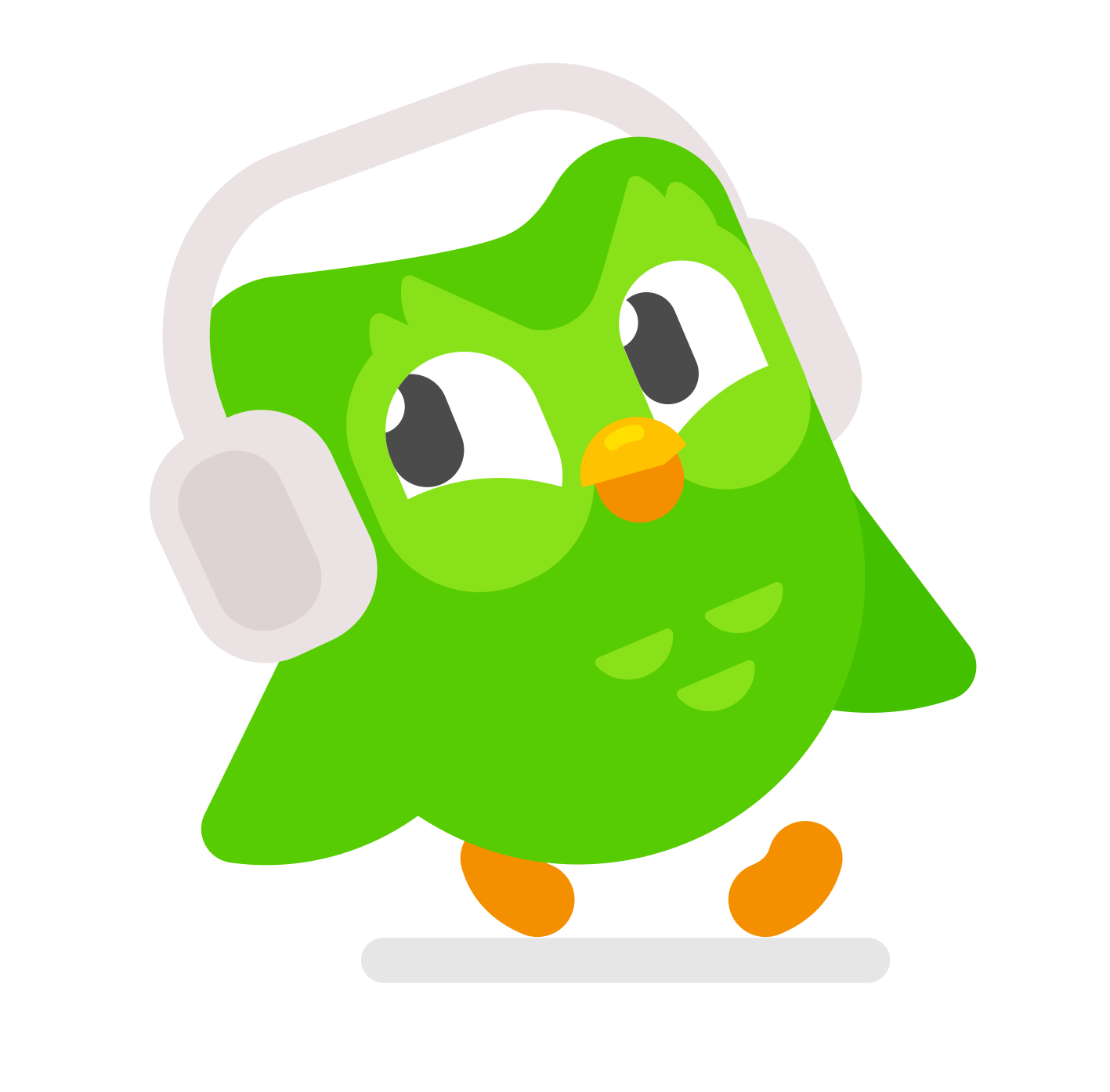Welcome to another week of Dear Duolingo, an advice column just for language learners. Catch up on past installments here.
Hey, learners! This week, I've teamed up with Emma Gibson to answer a question that we think is as interesting to English speakers as it is to English learners. Emma's no stranger to the Duolingo Blog—you'll know her from posts about North American Halloween traditions and how to say "yes" around the world—but it's her first time writing for Dear Duolingo! Emma works on the Duolingo Podcast and all sorts of listening features, and she's also developed content for some of our English courses, including English for Hindi speakers and English for Spanish speakers.
This week's question is from a learner in Latin America, and here's their question in English:
Our question this week:

This is a question worth asking because it's easy for English speakers and learners alike to forget how *strange* English is in a lot of ways. Sure, it's the #1 language to study globally, and English is often already familiar to learners, who get exposure to English through music, movies, and tourism—but let’s not overlook English's weirdness! Whether you're a learner studying English or an English speaker curious about how English pronunciation compares to other languages, read on!
Here are just a few ways that English pronunciation is unlike many other languages:
- English "th." English has not 1 but 2 "th" sounds (in words like "think" and "the")—and this is a pretty uncommon sound across the world's 7000+ languages! Even many dialects of English use other sounds in place of the difficult-to-hear and difficult-to-make "th" sounds.
- English "r." The English "r" is also sort of unusual when it comes to sounds used in the world's languages. Even though we use the same letter for English "r," Spanish "r," and French "r," these are different sounds requiring totally different movements of your tongue. 🤯 There are even 2 different ways that English speakers move their tongue to produce this sound, it just depends on how you figured out how to do it as a baby!
- English consonant combinations. English words can have a lot of consonants in a row, and many languages have a stricter limit on how many consonants can be pronounced right after each other. Take the word "sixths," for example: That's 4 consonant sounds in a row at the end of the word—k+s+th+s—not to mention your tongue has to jump back and forth between the "s" sounds to get it all out. In fact, not even all dialects of English even go through the trouble of saying all 4 consonants!
- English spelling rules. English has an especially inconsistent spelling system, and often 1 sound has many possible spellings… and many letters have multiple possible pronunciations. Sometimes the spellings of sounds can even seem a little wacky!
As you can already see, when we talk about pronunciation, we'll be contrasting English letters with English sounds. As we dig in deeper, we'll include symbols from the International Phonetic Alphabet in consonant and vowel charts to help you remember the differences.
General rules for English pronunciation
No matter the language, conquering new sounds is one of the biggest challenges for learners. And it's no different when it comes to English! There are many general tips for improving pronunciation that learners will find useful, but here are a few that are specific to English:
📣 Learn which part of the word is stressed.
Stressed syllables are louder and longer than the other parts of a word, and they are really important for English! Listen out for which part of a word is pronounced louder and longer than the rest of the word. When you complete your lessons, pay attention to which vowel is stressed in each word, and then do something: write it in a different color in flashcards or write it in all caps on sticky notes to help it, er, stick! Getting word stress right will help you be understood, because sometimes a stressed syllable is the only difference between similar words.
🔎 Vowels are really different depending on the dialect.
English dialects can vary dramatically, not just in words and grammar, but also in pronunciation! Vowels especially can change a lot from one dialect to another, so if you hear a word that's similar to a familiar word but not quite the same as what you expected, it could be a dialect difference!
🚧 You can't rely on English spelling.
Unfortunately, you often can't rely on spelling to know how to pronounce an English word! Instead, start by learning the main patterns (you can find them in the charts below!) and focusing on the words you see the most—these are sometimes called "sight words" in English, because the best way to learn how to pronounce them is to just memorize them (by sight)! For example, "do" and "been" are sight words because their vowels don't follow the typical patterns.
Tips for pronouncing English vowels
English speakers are taught that English has 5 vowels (and sometimes "y")—and that's true when it comes to letters... but English has many more vowel sounds! In fact, English has a lot more vowels than many languages, especially compared to languages like Spanish and Japanese (which just have 5 vowel sounds). Depending on the particular dialect, English has more than a dozen vowel sounds 😱 All those vowel sounds are written with just 5 letters, so keep in mind that here we're talking about how to make the sounds.
Because English has so many vowels, the differences between them can sound small to learners (or even impossible to hear!), so they are really worth practicing. To learn the sounds of English, you'll need to practice hearing them as well as pronouncing them yourself. That means listening practice is really useful, especially when it comes to similar words that have different vowel sounds.
For the full chart of English vowel sounds, how they are typically written, and example words, check out the vowel chart at the end of this post. Remember that there can be a lot of vowel differences across dialects, and this chart gives examples primarily for North American English!
Here are tips for studying English vowels:
🚨 Find that stressed vowel!
We're repeating ourselves, but that's how important this tip is! The best thing you can do to practice English pronunciation is identify the stressed part of the word. In English, the stressed syllable gets all the attention, and the other vowels in the word are often pronounced with the vowel schwa—this is a vowel made with your tongue and mouth totally relaxed. That means the unstressed syllables can all sound the same, no matter what vowel is used to write the word!
To test yourself, listen to these 5 words and decide which syllable in each word is the stressed one—you can check your answers at the end of this post.
- amazing
- natural
- pronunciation
- contract (noun)
- contract (verb meaning to get smaller or catch an illness)
(Can you hear the different stressed syllables in those last 2?)

👯♀️ English has lots of hidden diphthongs
Diphthongs are two vowels pronounced together, and English has a lot of them—sometimes they'll even be written with one letter! You'll find them in words like "out," where the first sound is pronounced /aʊ/ (in the IPA system), but there are also many English diphthongs that are written with just 1 vowel, like "kind" (/ɑɪ/). This won't be news to English learners, since many languages use two letters or characters for diphthongs—but English speakers often don't even realize they are producing two sounds at once!
🤫 Listen out for the silent vowels
You might learn that English has "silent" vowels, especially the notorious "silent e" in words like "name" and "ate"—but they actually signal that the vowel before them is a diphthong! So a word like "not" has just one vowel sound (written with the IPA symbol /ɑ/), but "note" with that silent e is pronounced with the diphthong /oʊ/.
😬 If it helps, try cheating
For learners, it can be really challenging to learn to move your tongue in new ways to pronounce English vowels—that's totally normal! While you work on mastering the difference between "seat" (with the vowel /i/) and "sit" (/ɪ/), there's another way learners can make these words sound distinct: length. English speakers don't even realize it, but they generally pronounce /i/ (as in "seat" and "feet") longer than they pronounce /ɪ/ (as in "sit" and "it"). The difference is a matter of milliseconds, but by making your English /i/ a little bit longer and your attempts at /ɪ/ a little bit shorter, you can help yourself communicate more clearly to English speakers!
Tips for pronouncing English consonants
English consonant sounds might be a little more predictable than English vowels, but there are still some guidelines to keep in mind. Just like we recommend for vowels, to practice pronouncing consonants start with the main patterns (like in the chart of English consonants) and then work through the most common words you encounter (which are often the exceptions!).
Here are more tips for learning English consonants:
😛 English has 2 "th" sounds
"Th" sounds are relatively uncommon around the world, and yes, English has 2 of them. You make these sounds by putting the tip of your tongue just barely between your teeth, so that it sticks out a little bit. You can practice by looking in a mirror to check if it's sticking out enough! One of the "th" sounds is voiceless, which means it's pronounced without vibrating the vocal folds in your throat—this is the version of "th" in "think," "bath," and "thank." The other "th" is voiced, so your vocal folds will vibrate—this is the "th" in "this," "bathe," and "them." (Don't worry, this voiced/voiceless difference is also the difference between "f" and "v," and "s" and "z," so your mouth already knows how to do it!)
🏴☠️ English "r" changes how vowels sounds
Learning to pronounce English will have you saying "arrrgghhh"! Whenever the English "r" sound comes after a vowel, it'll make the vowel sound sort of like an "r," too. You might not even hear the vowel at all! In words like "car" and "before," the vowels "a" and "o" become "r"-like (even though English speakers don't realize we're doing it).
🔨 English "t" and "d" change in the middle of words
English "t" and "d" are more complicated than they might seem: The English "t" is pronounced with a puff of air at the beginning of words, and both "t" and "d" can change their pronunciations even more dramatically inside many words. When they occur in pairs in words like "butter" and "ladder," they are pronounced by quickly tapping your tongue against the roof of your mouth—not really as a "t" or "d" at all!
No need to stress about English pronunciation!
The good news about English pronunciation is that learners can find lots of ways to practice both listening and speaking: Review the sounds and spellings in the charts below, pay attention to stressed syllables and exceptions in your lessons, and find fun ways to practice hearing and pronouncing English, like with music and movies and TV!
For more answers to your questions about English, get in touch with us by emailing dearduolingo@duolingo.com.
Which part of the word is stressed?
- aMAzing
- NAtural
- pronunciAtion
- CONtract (noun)
- conTRACT (verb meaning to get smaller or catch an illness)
How to pronounce English vowels
As you read above, different dialects of English can have really different ways of pronouncing words, especially when it comes to their vowels! The example words in this chart represent the most common pronunciation of each word in American English, but you'll likely encounter other pronunciations as well.
| IPA symbol | Some English spellings | English examples |
|---|---|---|
| /i/ | ee ea ie e y ey |
see meat niece be very money |
| /ɪ/ | i ee y |
with been gym |
| /eɪ/ | a ai aigh ay ea eigh ey |
station Spain straight day great eight they |
| /ɛ/ | e ea ie |
egg head friend |
| /æ/ | a au |
has laugh |
| /ʌ/ | a o oe oo ou u |
what of does blood young cup |
| /ɑ/ | a au augh aw o ough |
father sauce taught draw not thought |
| /ɔ/ Note: This sound only exists in some dialects! |
au augh aw ough |
sauce* taught* draw* thought* |
| /oʊ/ | o oa oe ow |
old road goes bowl |
| /ʊ/ | oo u |
book put |
| /u/ | ew oo ough u ue |
news room through flute blue |
| /ɑɪ/ | eigh i ie igh uy y |
height idea lie night buy why |
| /ɑʊ/ | ou ow |
out brown |
| /ɔɪ/ | oi oy |
noise boy |
How to pronounce English consonants
| IPA symbol | Some English spellings | English examples |
|---|---|---|
| /m/ | m | map |
| /n/ | n kn |
no know |
| /ŋ/ | ng | sing |
| /p/ | p | pink |
| /b/ | b | boy |
| /w/ | w wh |
want what |
| /θ/ | th | think |
| /ð/ | th | these |
| /f/ | f ph |
four telephone |
| /v/ | v | very |
| /t/ | t | two |
| /d/ | d | dog |
| /s/ | s ss c z |
soap boss peace quartz |
| /z/ | s z |
dogs zoo |
| /ʃ/ | sh | shoe |
| /ʒ/ | s ge z |
pleasure beige azure |
| /tʃ/ | ch | child |
| /dʒ/ | g j dge |
age job bridge |
| /ɾ/ | tt dd |
butter ladder |
| /ɹ/ | r wr |
red write |
| /l/ | l ll |
like yellow |
| /j/ | y | yes |
| /k/ | c k ck |
cat kid black |
| /g/ | g | go |
| /h/ | h | hat |
| /ʔ/ | (not written!) t tt |
uh-oh Latin button |



